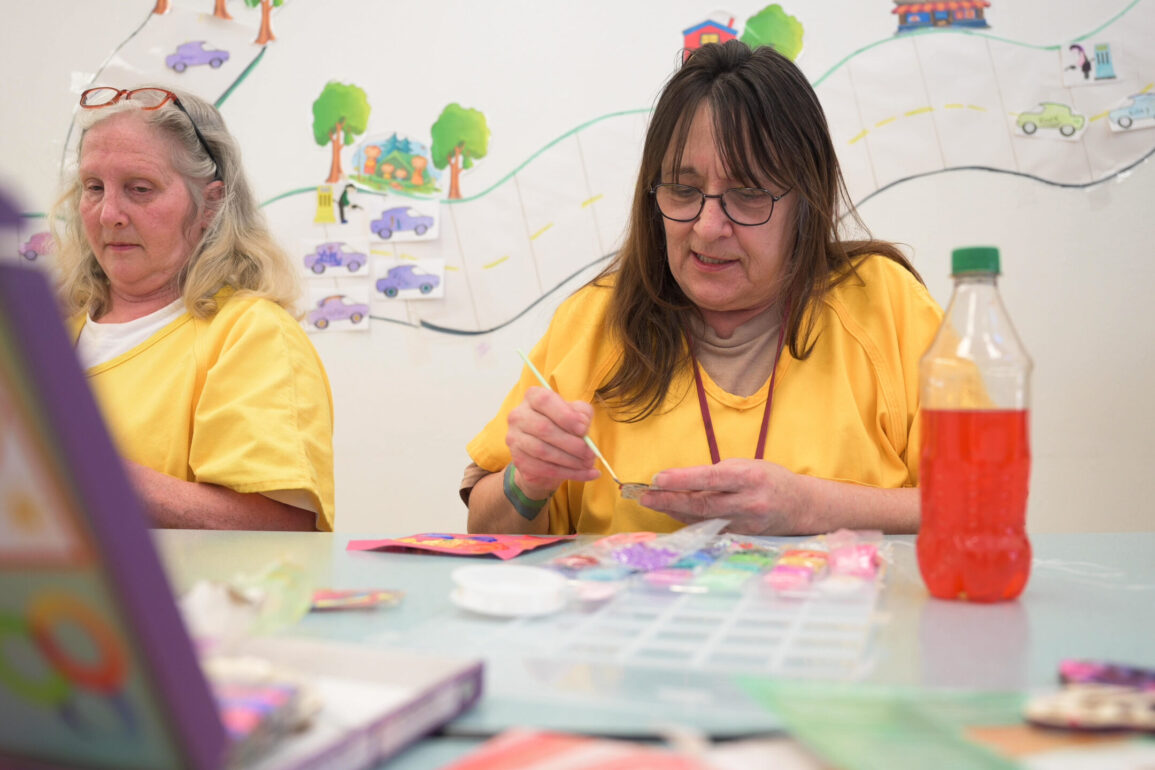
On a recent Tuesday, Jamey Bradbury stood in front of about nine women, all wearing yellow jumpsuits. They were in a classroom inside Hiland Mountain Correctional Center in Eagle River, and Bradbury was leading the last session of her class, Tapping Into Your Creative Self. The aim was to show students that everyone has a creative side and you don’t need elaborate materials to access it.
“What I like to do is kind of baby step people into creativity, into taking a risk that might be scary for them,” Bradbury said.
Bradbury began by pulling out dozens of tiny packages of Play-Doh and distributing them across the table. She gave a few different prompts and the women started kneading and shaping the colorful dough.
Hiland currently houses about 350 women and 15 signed up for Bradbury’s six-week class, though a few have been released during that time. Bradbury doesn’t force any participation and when she held the acting session, two women chose to leave. But students have sometimes surprised themselves when they’ve tried new things, like Tanya Parker.
“I wrote my first poem a couple of weeks ago,” Parker said. “I was so happy I did something like that. I was proud of myself, but I wouldn’t have been able to do it if I didn’t come to this class.”
She pulled her poem out of a folder next to her.
“It’s called ‘My Home,’” Parker said. “My home is not made of bricks, my heart is not made of stone, my soul is not made of ashes…”
Parker said that since writing that poem, she’s also reading poetry for the first time. The classes have also taught her to feel comfortable speaking in front of a group, she said, something she’s always avoided. And she said that new confidence will help her once she’s released, in under a month.
“I’m gonna stand up for myself,” Parker said. “You know, if people don’t like the way I say or what I say, they don’t have to come around. I am who I am.”
About 5,000 Alaskans are incarcerated in almost 30 prisons and jails in the state, and the number of incarcerated Alaskans has tripled since the 1970s. Arts classes like Bradbury’s are shown to reduce both violence inside prisons and the rates of recidivism, people returning to prison once released. But a spokesperson for the Department of Corrections said only a quarter of jails and prisons in Alaska offer some kind of arts class.
Bradbury began teaching writing classes here in 2018 and she’s an unpaid volunteer. She said her understanding of what students want and need has evolved and so she’s offered a wide variety of classes over the years, including poetry, journalism, and memoir writing.
One of the themes Bradbury talks about in her classes is the healing power of art. Studies have shown making art has many health and mental health benefits.
That’s something Jessica, one of Bradbury’s students, has noticed. Jessica doesn’t want to give her last name.
“As Jamey has taught us, doing stuff with your hands allows your mind to go other places,” Jessica said. “It’s therapeutic and allows you to deal with issues or trauma that you need to work through that you don’t necessarily have the opportunity to in here.”
Jessica said the classes have transformed how she feels about her classmates. She said in prison, people often have to wear a metaphorical mask to get through the day, to try to not think about what they’re missing on the outside. But she said Bradbury’s classes are a safer space to be vulnerable.
“It allows us to be able to take off that mask that you have to wear in a place like this,” Jessica said. “And we can smile at each other just in passing or in (the) food line, and know that it’s not a fake smile… know a little bit about the person that we never would have known otherwise, because they live in a different house, or they keep us separate.”
Jessica said she plans to keep writing after she’s released and hopes to publish something about her time in prison.
Bradbury said her students have processed intense emotions during writing classes. She said in a memoir class, several students chose to write about the crime that led to their incarceration and the students were surprised to see there were many similarities in those stories. Bradbury said everyone in class who shared their story cried.
But she said the classes also have lots of fun, light moments and can be a break from prison life.
“You look around, and you see people in yellow jumpsuits, and you remember, ‘Oh, I’m in a prison,’ but you pretty quickly forget that,” Bradbury said. “And I think that for a few minutes, at least in the class, they’re able to forget that too, and it’s just a group of women crafting together, hanging out together, laughing together.”
Bradbury said she hopes this class has taught her students they can find ways to be creative wherever they are, inside the prison or after release.
RELATED: See a video of this story and a discussion of life after incarceration on Alaska Insight
This post was originally published on this site be sure to check out more of their content.







